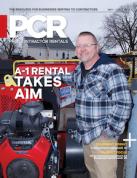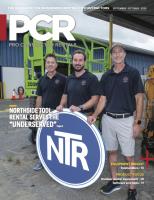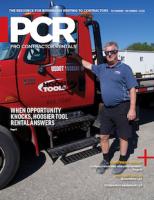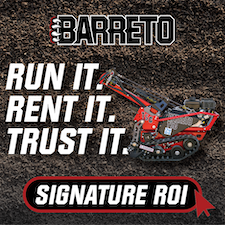Build Your Business -- Automate your way to growth
Seven ways to improve operational efficiency to drive rental business growth.
By Malcolm Roach
Every equipment rental business is battling the pressure of a possible recession and facing the same conundrum: How do I grow my business strategically without hiring more people for everything?
Hiring more people presents risks and costs that aren’t well-timed in periods of economic uncertainty. No matter the state of the economy, it’s always the aim to run as lean as possible while still providing the best service, operating efficiently, outpacing the competition and improving the bottom line.
As a rental business grows, so does the pressure to add more resources. Sometimes this is done aimlessly, causing more overhead than you need and more issues to untangle down the road.
You may already have a great team ready to build and expand your operations or you just want to avoid the headaches of recruitment. Either way, you’re looking for opportunities to scale without spending a ton of money and time looking for more talent.
It’s common to react by throwing more people and money at a challenge as you experience pressure to grow. With a solid tactical plan and the right timing, you can minimize many risks to your rental business and allow it to thrive, even in more trying times.
Here are seven proven strategies to grow your equipment rental business with minimal dollar investment for maximum ROI.
1. Identify your strengths and weaknesses
Before bringing in new business, you need to know what’s already working and what’s not. By interviewing customers and analyzing customer data, you can uncover where you are making and losing money. Here are some questions to consider:
- Who are your most profitable customers, and why?
- What equipment do your customers rent the most?
- Do you have idle inventory that’s currently wasting space?
- Is your equipment regularly maintained and in working order?
- What areas of your rental operation are inefficient?
- Is there an area of your business you can leverage more?
To answer these questions, you need to have a business management system that can produce reports with the relevant insights. If your current software doesn’t provide these types of reports or you don’t have them set up yet, you should focus your efforts here first.
Many equipment rental businesses that are successfully expanding use Microsoft’s Power BI in conjunction with an industry ERP software solution to pull valuable data and analytics segmented by top products, regions, seasons, customers and more. This level of visibility will provide the insight you need to grow your rental operation.
2. Evaluate your supply sources
When scaling up your rental business, be ready for a higher volume of bookings. It doesn’t matter if you are renting construction trucks or generators; you need to be able to add more stock to your inventory to meet demand without breaking the bank.
Ultimately, the goal is to ensure you always have products on hand in case your bookings exceed your inventory capacity. If your current supplier can’t
offer the turnaround you need, you might have to search for a local supplier. Another option is sub-renting from other local rental businesses. Some equipment rental ERP solutions allow you to easily track and re-rent equipment to your customers sourced from competitors and third parties. This capability helps prevent overbooking and generates a linked purchase order to match a supplier invoice.
3. Get familiar with financials
Before considering cost-effective alternatives that will help reduce monthly outlay, see what you’re spending. Instead of simply producing required financial statements, take the time to really analyze them and find out where your profits and losses are coming from. This is a critical step toward growth.
If you have a rental management software system in place, you can set up regular reports and dashboards with valuable key performance indicators (KPIs) and have this information at your fingertips. With insight and visibility over the right financial metrics, the team can focus on what is driving the business forward and make decisions that create efficiencies without adding new talent.
4. Keep tabs on your competition
It never hurts to look around and see what your competitors are doing. By studying the market continuously, you stay in the loop on changing rates, evolving demands, new products and services and other important information. In this process, you’ll also discover what new or different equipment and services your competitors offer that you may want to add to your inventory.
If you have a particular local or industry competitor in mind, you could set up a secret shopping exercise and take notes of the customer experience. You’ll be able to stand in your customers’ shoes and decide what works well, what they could improve on and what you can then capitalize on.
5. Look for revenue opportunities
The purpose of developing your equipment rental operations is ultimately to increase revenue. You don’t need to add new employees or invest in new equipment to find other avenues that generate business and additional profits. Here are some examples:
- Expand your marketing efforts to grow your online presence and drive new business by running a targeted ad campaign
- Add new services or offerings that complement your existing rental business
- Invest in sub-rentals to keep up with supply and demand
Your existing team has a wealth of insightful experience and they probably have plenty of ideas as well. Tap into that experience and creativity with team brainstorming sessions, including people from across the company. Sometimes simple but incredibly valuable ideas can come from the people you least expect.
6. Expand your online presence
One of the best ways to grow business is through online marketing and building brand awareness. By getting your brand and its products and services in front of more faces, you can reach more relevant traffic and convert them to customers faster.
A single investment in a targeted ad campaign or an optimized website can generate new sales leads and yield significant profits. Additionally, it will help improve the customer experience by providing prospects with all the information they need to make a purchase. When they have access to details like the types of rentals you provide, how much they cost and what insurance options you offer online, you get more qualified buyers showing up at your door. The more information you supply to a prospective buyer online, the fewer resources, money, effort and time are spent getting new customers.
What goes into new marketing efforts will depend on your budget and whom you have on staff that can maintain your online presence. Often, outsourcing work to a marketing agency will cost less than hiring a new employee.
7. Leverage technology to automate core tasks
There are many moving parts in an equipment rental business and if you don’t have a centralized rental management solution to handle rental inventory, customer invoicing, servicing, field ticketing, sub-rentals and finances it will be harder to scale because you’re running your equipment rental operations based on disparate systems, manual processes and inaccurate data.
At the end of the day, the more manual and administrative your operation is, the more people are required to keep the business running.
If your goal is to grow but not hire more staff, you will need an integrated equipment rental management solution to automate these core processes. It will also give you the performance visibility you need to make faster, more actionable decisions based on real-time, accurate data.
-30-
Malcolm Roach is CEO at Open Door Technology.
This article originally appeared in the January-February 2023 issue of Pro Contractor Rentals magazine. ©2023 Urbain Communicaitons LLC. All rights reserved.










